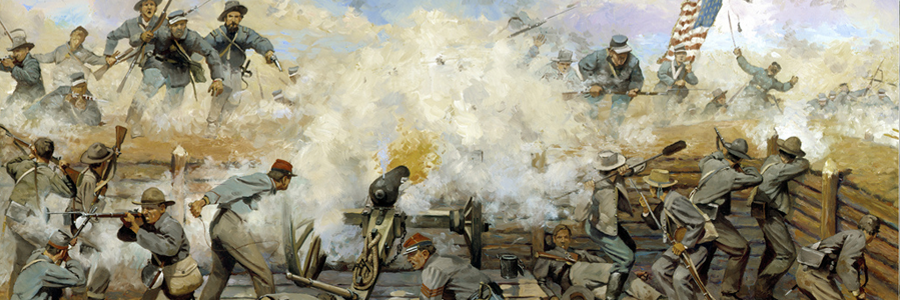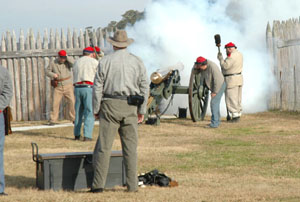
Fort Fisher State Recreation Area
1000 Loggerhead, Kure Beach, NC 28449 (910) 458-5798
Park Hours
November - February, 8 a.m. - 6 p.m.
March - October 8 a.m. - 8 p.m.
June - August, 8 a.m. - 9 p.m. Closed Christmas Day
Park Office Hours - Open most state holidays
8 a.m. - 5 p.m. daily
E-mail: fort fisher@ncdenr.gov
The Fort Fisher State Recreation Area contains the remainder of the batteries. Still existing, but hard to distinguish among the sand dunes, are the remains of Batteries Lenoir, Hendrick(behind the Visitor Center), Lamb and the Mound.
North Carolina Coastal Defense System
History of Fort Fisher (Southport, NC)
The city of Wilmington is located 29 miles upstream from the mouth of the Cape Fear River, which flows into the Atlantic Ocean. During the war, Wilmington was one of the most important points of entry for supplies for the Confederacy. Its port traded cotton and tobacco in exchange for foreign goods, like munitions, chothing and foodstuffs. Trade was based on the coming and going of steamer ships of British Smugglers. These vessels were called "blockade runners" because they had to avoid the Union's imposed martime barricade. Mostly, the blockade runners came indirectly from British colonies, such as Bermuda, Bahamas, or Nova Scotia. Often, they were forced to fly the Confederate insignia since the Union had imposed the death penalty on British "pirates" captured in the region.
After the fall of Norfolk, Virginia in May 1862, the importance of Wilmington was further increased. It became the main Confederate port on the Atlantic Ocean. Considering the Atlantic seashore, Wilmington's defenses were so sturdy that they were only surpassed by Charleston's, in South Carolina. Wilmington resisted for a long time, mainly because of Fort Fisher's presence
Fort Fisher was the main Confederate fort protecting the vital trading routes of the port at Wilmington from 1861 until its capture by the Union in 1865. The fort was located on one ofCape Fear River''s two outlets to the Atlantic Oceanon what was then known as Federal Point and today is known as Pleasure Island. Because of the roughness of the seas there, it was known as the Southern Gibraltar.
Fort Fisher was rather insignificant at first, until Confederates expanded the fort in 1862. This then became Wilmington's primary defense. The Confederacy increasingly depended on blockade runners breaking through the Union Navy lines to maintain trade necessary to sustain the war effort. An average of one ship a day ran the blockade successfully throughout 1863 and 1864. With two inlets on the Cape Fear River, dangerous shoals to trap Union ships lacking the knowledge of local river pilots, the Cape Fear River made an ideal spot for blockade running. A Union attack failed in 1864, but another one was successful in January, 1865. Once this fort fell, other forts were soon abandoned and the Confederacy's last remaining port was shut down. Without a supply line, the Confederacy was doomed and the war soon ended. An "L"-shaped fortification, it was actually a line of batteries connected by earthworks. Shepard's Batteryand part of the land face is all that is left of the fort today within the state park. An old WWII Army Air Force landing strip and US 421 runs through this segment of the fort. The State Historic Site Visitor Center is in the middle of this former airstrip. Now eroded into the sea is the Northeast Bastionand the sea face batteries of Meade, Cumberland , Columbiad, Bolles, Purdie, and the Roland. The Surrender of Cape Fear Area


